For a full scale picture, please click on the picture shown !
Augsburg trams - Augsburger Verkehrsgesellschaft AVG / swa Stadtwerke Augsburg
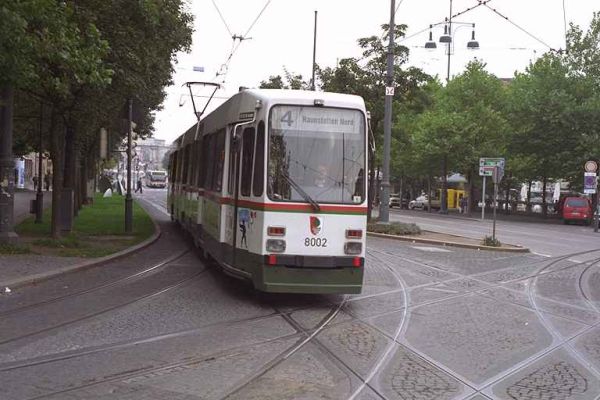
Augsburg tram 8002. This is a MAN type M8C from 1985.
Photo by Erik Hjelme 23 September 1995.
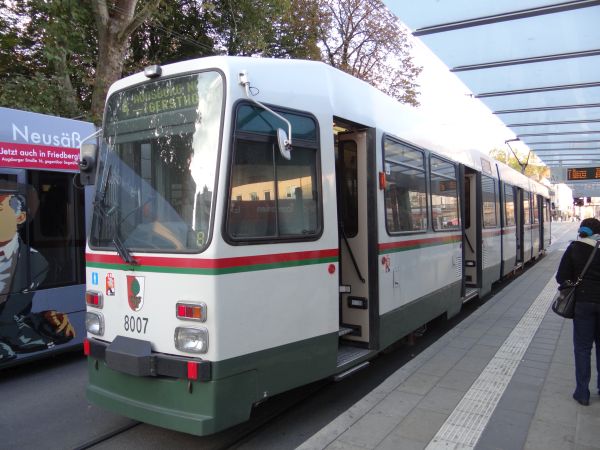
The tram type Augsburg M8c has two drivers' cabs and doors on both sides, so it doesn't need a proper turnaround loop. These are the only
Augsburg trams with two cabs. Augsburg is already trying to get rid of these high-floor types. Some of them have been sold to Elblag
in Poland and some others to Darmstadt. There were originally 12 of these trams and five were already sold 2012-13.
Picture from Augsburg Hauptbahnhof 9.10.2015 by Ilkka Siissalo.
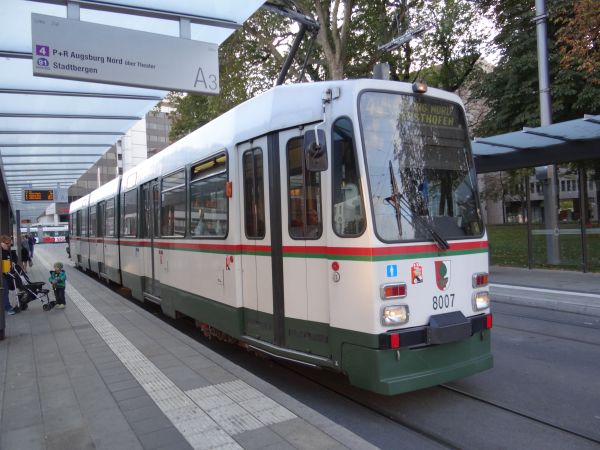
Same M8c tram as above, seen from the other side.
Picture from Augsburg Hauptbahnhof 9.10.2015 by Ilkka Siissalo.

Inside view of an M8c tram. The lady in the picture is train photographer Sanna Siissalo.
Picture from near Augsburg Hauptbahnhof 9.10.2015 by Ilkka Siissalo.

Augsburg tram 408. This is an old Rastatt GT4 from 1951, renovated/modernised in the 1970s.
Photo by Erik Hjelme 23 September 1995.
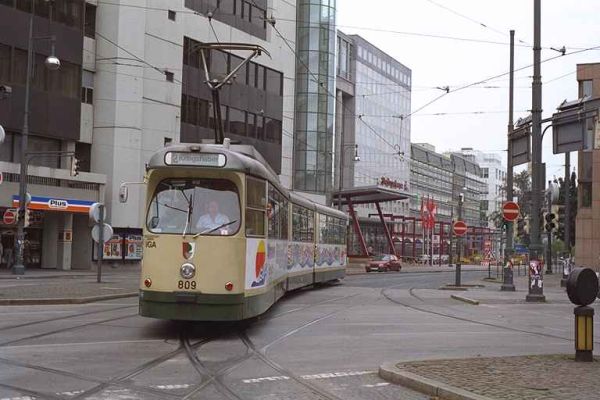
Augsburg tram 809. This is of the type MAN GT8.
Photo by Erik Hjelme 23 September 1995.

Augsburg tram no.826 is a Siemens Combino, here on the street Herrmannstrasse on line 1 to Göggingen. These Combinos
were delivered to Augsburg 1999 to 2004 and there are 41 of them in use.
Picture 9.10.2015 by Ilkka Siissalo.

The same Augsburg tram no.826 at Herrmannstrasse on line 1 to Göggingen.
Picture 9.10.2015 by Ilkka Siissalo.
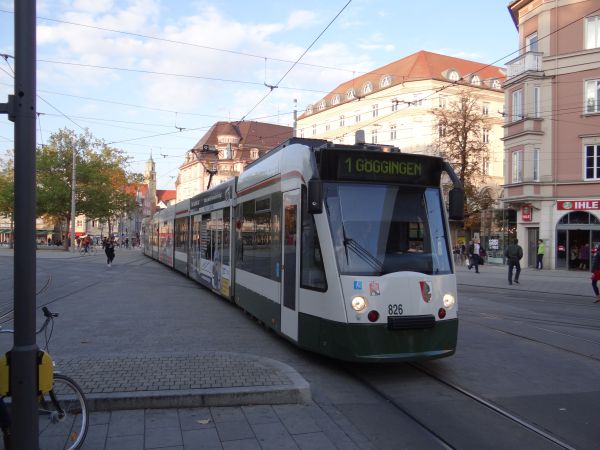
Same Siemens Combino as in the pictures above, but now at Königstor. This shows well the remarkable length fo the Combinos, up
to 45 metres in this configuration.
Picture 9.10.2015 by Ilkka Siissalo.
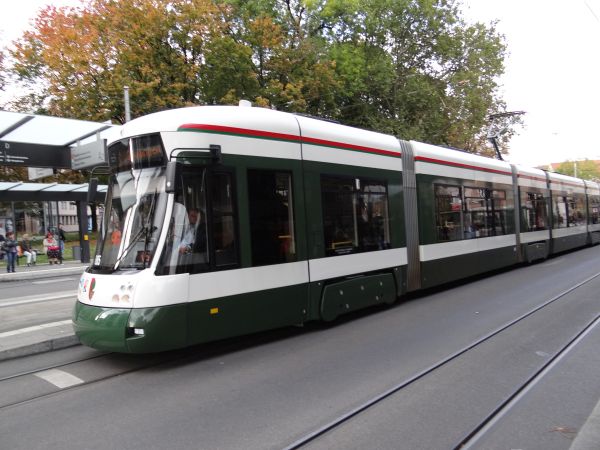
Even newer than the Siemens Combinos, this is a Bombardier CityFlex tram. Augsburg got 27 of them 2009-2011. The tram is extremely long.
Picture from Göggingerstrasse in Augsburg 9.10.2015 by Ilkka Siissalo.
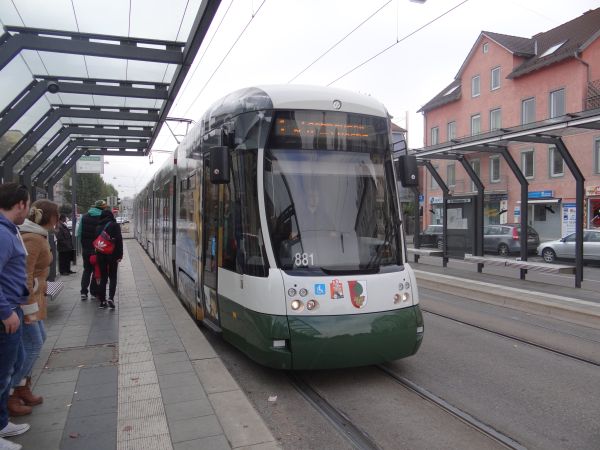
Another one of the Bombardier CityFlex trams, the no.881 is here stopping at the tram stop Kongress am Park by the Göggingerstrasse.
Picture from Göggingerstrasse in Augsburg 11.10.2015 by Ilkka Siissalo.
Braunschweig Trams - Braunschweiger Verkehrs-GmbH
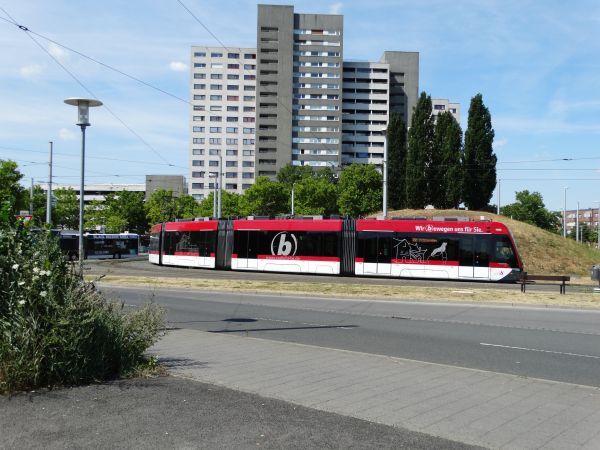
A new Solaris Tramino tram of the city of Braunschweig is turning in the loop in front of Braunschweig main station.
Picture 17.7.2018 by Ilkka Siissalo.

Braunschweig tram 9554 is of the type GT6S. It was built in 1995.
Picture from Braunschweig Hauptbahnhof 22.7.2004 by Ilkka Siissalo.
Dresden Trams - Dresdner Verkehrsbetriebe (DVB)
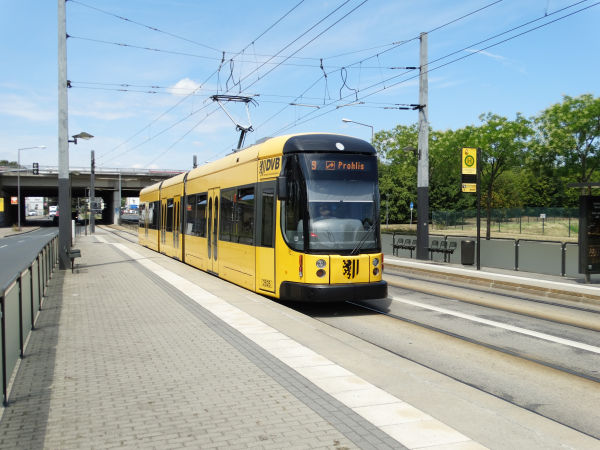
Dresden has today 14 tramlines and close to 200 trams. The network is operated by the Dresdner Verkehrsbetriebe, a part of the city
itself. After the communist times the tram network was in a desolate condition and it is a wonder how nicely services have been restored
by now.
This tram no.2626 is a Bombardier Flexity Classic 8 axle version. There are also similar 12 axle variants.
Picture from Dresden Washingtonstrasse 16.7.2018 by Ilkka Siissalo.
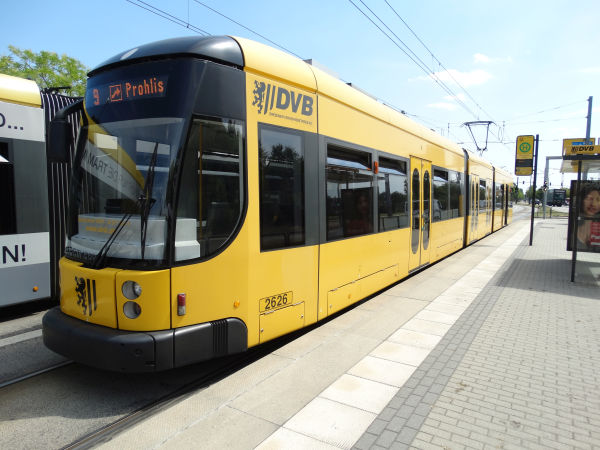
The same tram 2626 seen from behind.
Picture from Dresden Washingtonstrasse 16.7.2018 by Ilkka Siissalo.
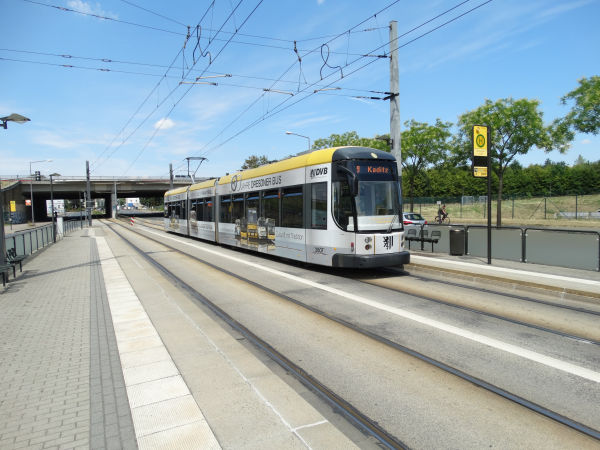
No.2607 is a similar Bombardier Flexity Classic 8 axle version as depicted above, but it has tapings advertising DVB's own bus services.
Picture from Dresden Washingtonstrasse 16.7.2018 by Ilkka Siissalo.
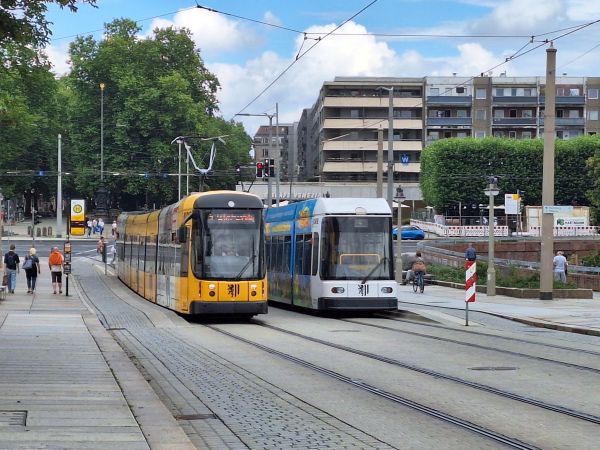
Two more Bombardier Flexity Classic five modules long trams of DVB.
Picture from the Königsufer 1.7.2024 by Petteri Holopainen.
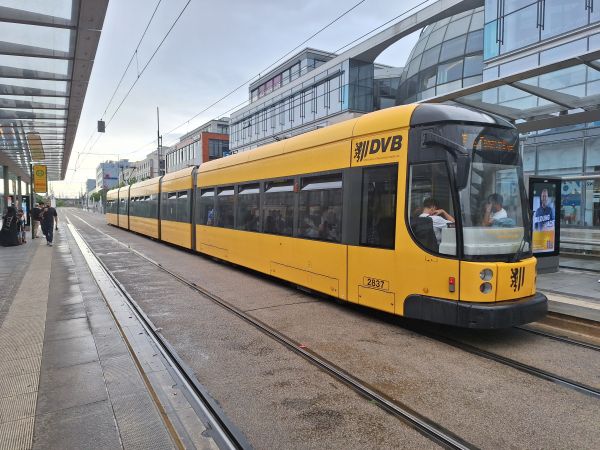
Five modules long Bombardier Flexity Classic trams are really long.
Picture from Hauptbahnhof Dresden 30.6.2024 by Petteri Holopainen.
Duisburg trams - Duisburger Verkehrsgesellschaft DVG

Duisburg tram 1001 is one of the type GT 10 NC-DU trams of Duisburg. They have driver's cabs at both ends and doors on both sides.
They run with 750 V DC on 1435 mm tracks. DVG has two tram lines. These trams have one short low-floor section. This tram was built
in 1986.
Picture from the train station of Dinslaken 7.7.2010 by Ilkka Siissalo.
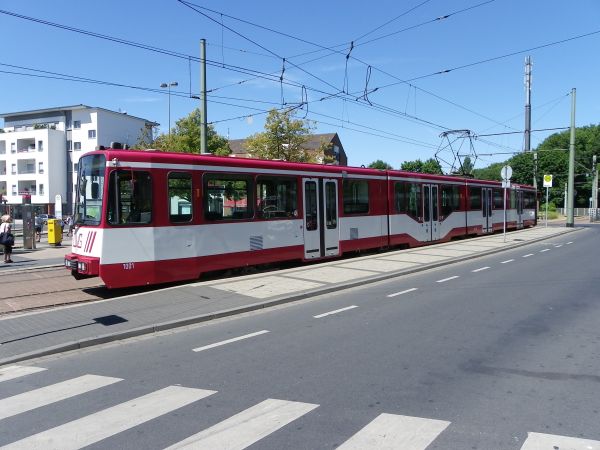
Side view of the same tram as above. When new, these trams had only three sections. The low-foor part has been later added.
Picture from the train station of Dinslaken 7.7.2010 by Ilkka Siissalo.
Trams of Erfurt / Erfurter Verkehrsbetriebe EVAG
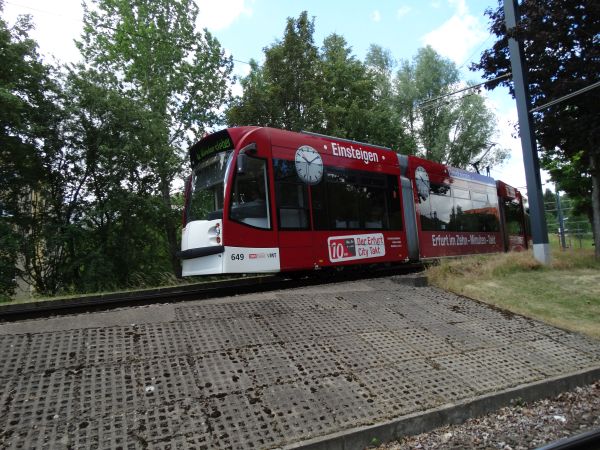
Erfurt is the capital city of the German state of Thüringen. Erfurt has five tram lines and most of the trams are of Siemens' type called Combino, either five
pieces or three pieces long. This one, number 649 is one of the five parts long Combinos. The network is of metre gauge and has a line length of 45,2 km.
Picture from the loop of line 4 at Erfurt Wiesenhügel 2.7.2019 by Ilkka Siissalo.

The same Combino as above, but now seen from behind.
Picture from the loop of line 4 at Erfurt Wiesenhügel 2.7.2019 by Ilkka Siissalo.
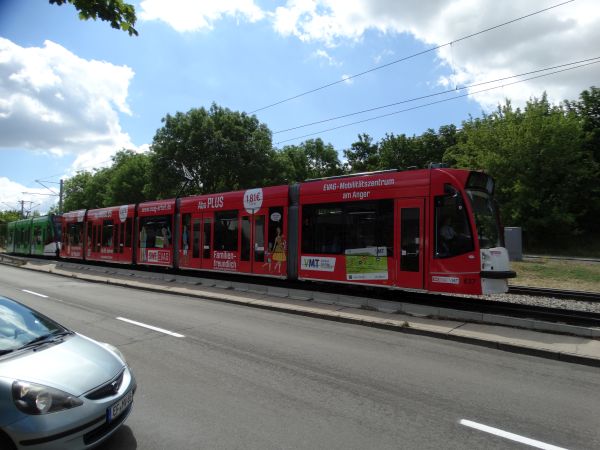
A typical Erfurt tram, consisting of one five pieces and one three pieces long Combino unit.
Picture from Erfurt Herrenberg 2.7.2019 by Ilkka Siissalo.
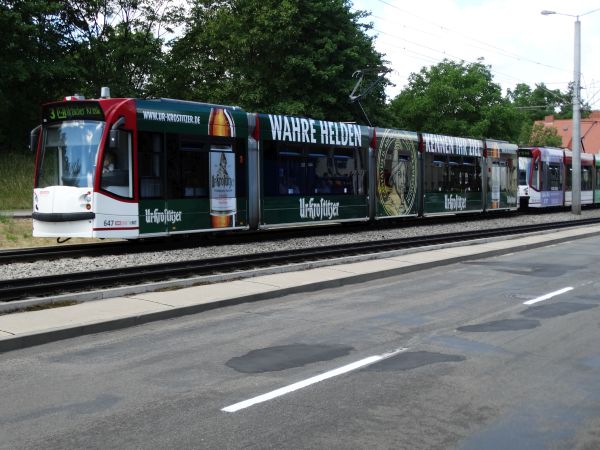
A similar long 5 part + 3 part Combino combination. Almost all of Erfurt's trams are covered by advertisement tapings.
Picture from Erfurt Herrenberg 2.7.2019 by Ilkka Siissalo.
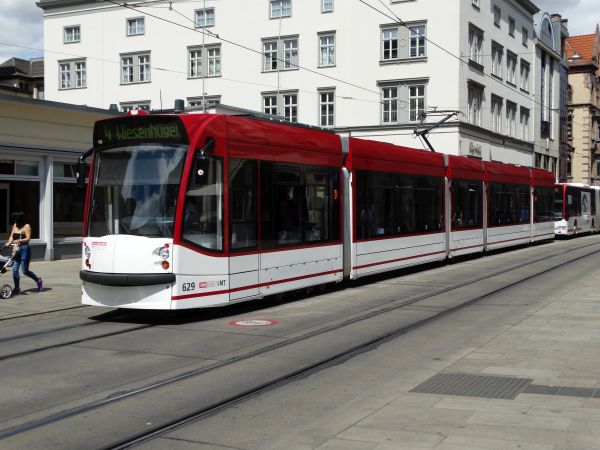
The five pieces long Siemens Combino no.629 is one of the rare ones, which has not yet been spoiled by ugly advertisements.
Picture from Erfurt Hauptbahnhof 2.7.2019 by Ilkka Siissalo.
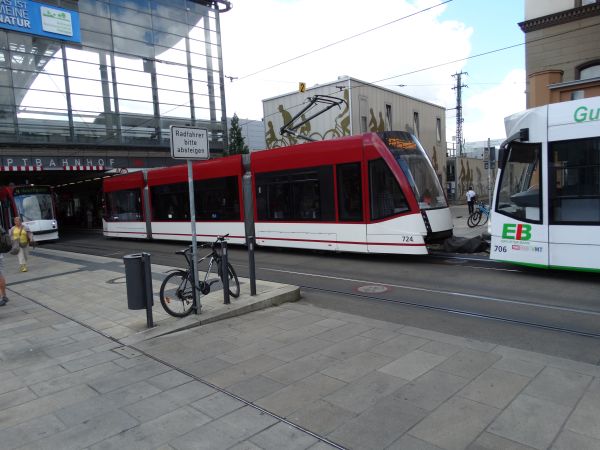
Likewise, the three pieces long Combino no.724 is still free of ads and looks good.
Picture from Erfurt Hauptbahnhof 2.7.2019 by Ilkka Siissalo.
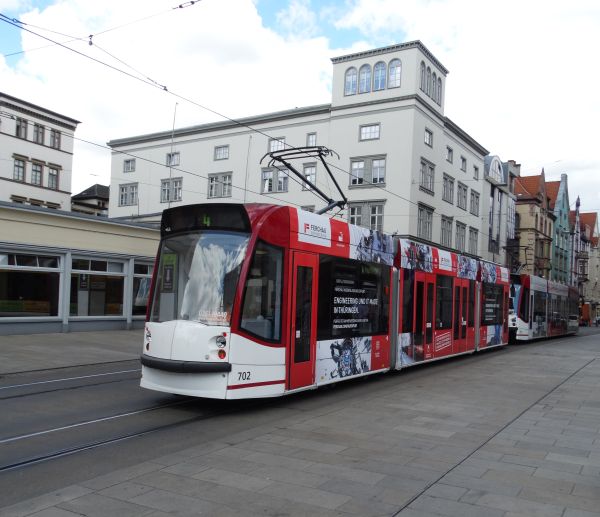
A three plus three pieces Combino on line 4.
Picture from Erfurt Hauptbahnhof 2.7.2019 by Ilkka Siissalo.

One of the very few trams in Erfurt which is not a Siemens Combino. This no.612 is an Adtranz MGT6D. These trams were assembled in Erfurt from parts
delivered from western Germany. Body parts were assembled in Bautzen. These trams were delivered from 1994 onwards and were all modernised 2011-2014.
Erfurt has 16 of these trams and four of them have driver's cabs at both ends and doors on both sides.
Picture from Erfurt Hauptbahnhof 2.7.2019 by Ilkka Siissalo.
Trams of Halle (Saale) - Hallesche Verkehrs AG HAVAG
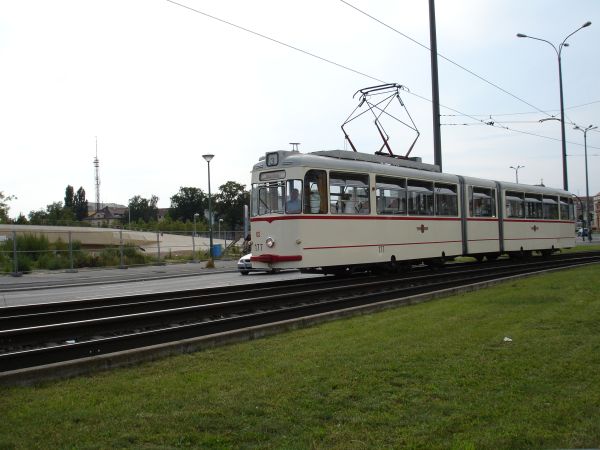
A famous old tram from the communist East German times, this is the Gotha tram nicknamed "two rooms and a kitchen", here seen as
a museum tram in its original communist time colours.
Picture from the outskirts of the city of Halle 21.7.2007 by Ilkka Siissalo.
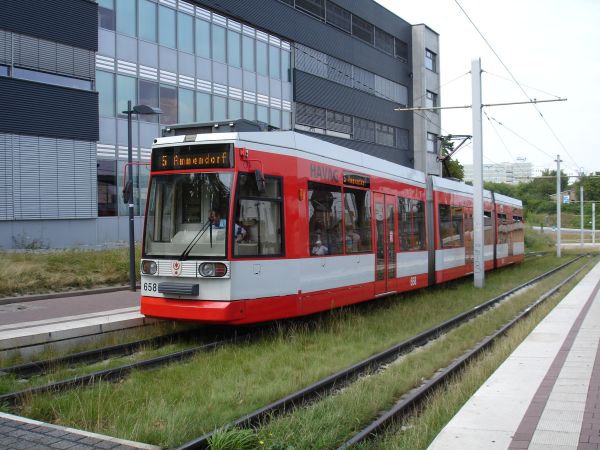
Halle's tram no.658 is a type MGT6D tram built by Düwag in Dusseldorf. It was the first western tram type delivered as new to Halle.
They arrived to Halle in 1992. It's a pure bidirectional model with steering cabs at both ends and doors on both sides.
Picture from main railway station of Halle (Saale) 21.7.2007 by Ilkka Siissalo.
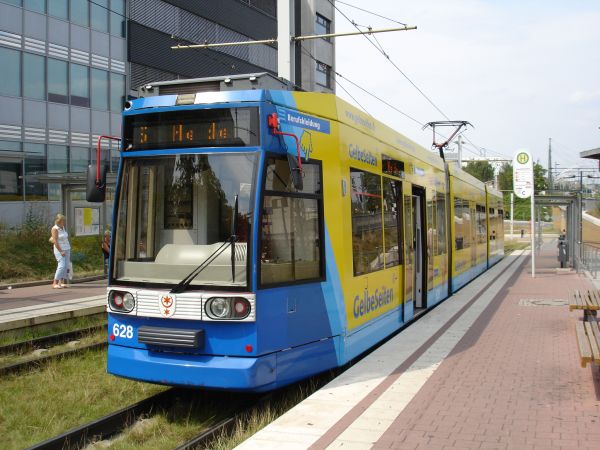
Halle's tram no.628 is a similar Düwag MGT6D than the one shown above, but it is fully covered by and advertisment of the
"yellow pages". In Halle many trams and buses are fully covered by ads.
Picture from main railway station of Halle (Saale) 21.7.2007 by Ilkka Siissalo.
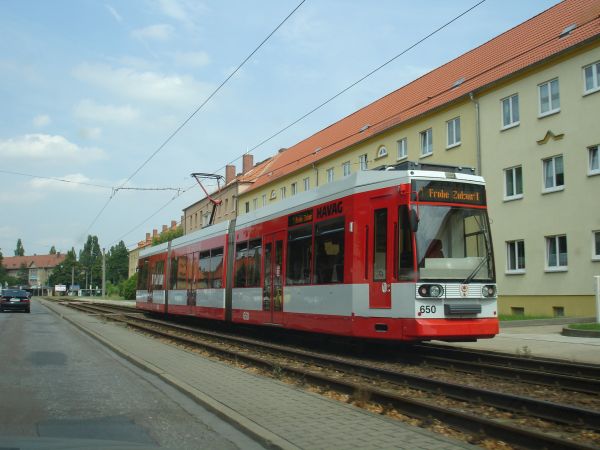
Halle's tram no.650 is yet again a similar Düwag like the ones shown above. Here it is seen in full speed at one of the city's
old suburbs built during the communist regime.
Picture from Halle (Saale) 21.7.2007 by Ilkka Siissalo.
Hannover trams - Üstra
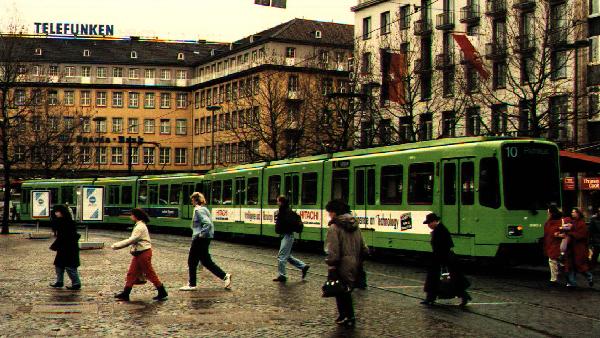
Class 6000 Hannover tram in front of main railway station. Photo in August 1996
by Ilkka Siissalo.

Class 6000 Hannover tram in front of main railway station. Photo in August 1996 by Ilkka Siissalo.
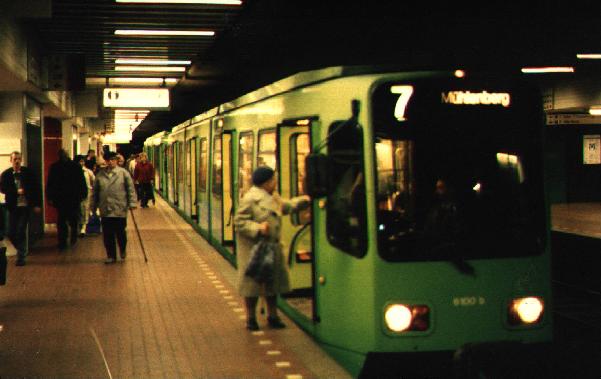
Class 6000 Hannover trams run in the city center underground in a metro like fashion. While stopping at the high metro style
platforms, they only open a part of their doors, thereby creating a level low-floor entry for passengers. While stopping at the street level
stops, the trams can also open the lower part of their doors together with stairs. Photo from one of the metro-like underground stations
in August 1996 by Ilkka Siissalo.
Trams of Leipzig - Leipziger Verkehrsbetriebe
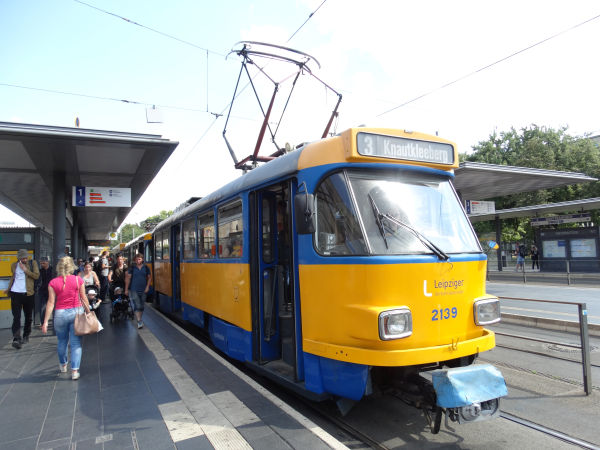
The classic tram of Leipzig, a Tatra T3 from communist times long gone by. These trams were once abundant across all of the communist
block countries of Europe, but nowadays an unmodernised Tatra T3 like here is a rarity - although this one has at some point of time
received at least new lamps and a more modern line number and destination sign system. Tatra wagons are nowadays used in Leipzig
mostly only at rush hours and mostly as three wagon trains as here. Notice how the second, similar Tatra T3 has its pantograph down
as it is used merely as an addtonal unmotorised wagon.
Picture from Leipzig Hauptbahnhof 16.7.2018 by Ilkka Siissalo.
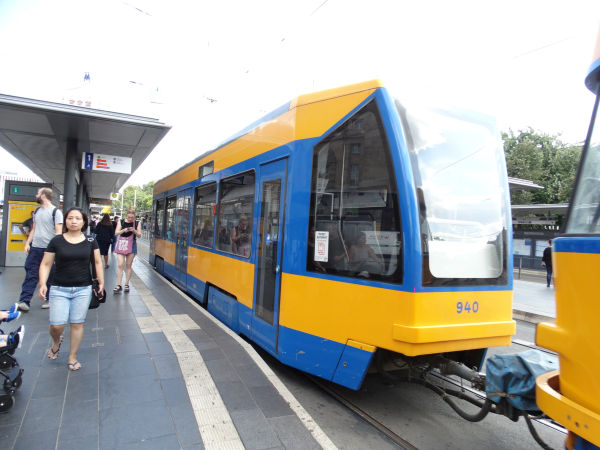
As mentioned above, old Tatra T3 trams are mostly used in Leipzig today as three wagon trains. Typically the last wagon is a new one
with a low-floor section. These low-floor new trailer coaches were first made for the city of Rostock, but as Rostock received more
and more of new trams and could get rid of its communist-time Tatra wagons, they could sell some of the new trailers to Leipzig.
This trailer wagon is a Bombardier 4NBWE built in 2013 for Rostock.
Picture from Leipzig Hauptbahnhof 16.7.2018 by Ilkka Siissalo.
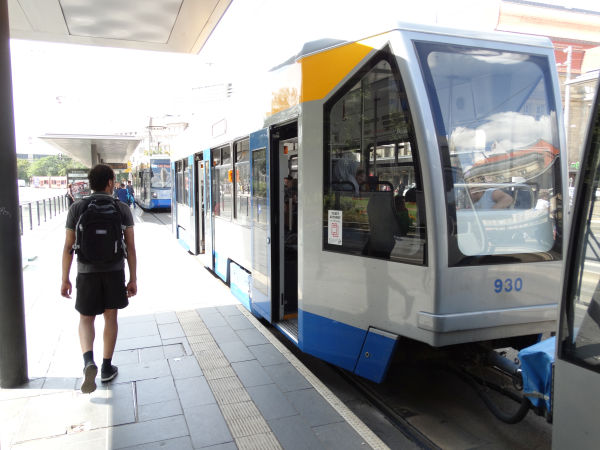
Some of the same modern Bombardier trailer coaches have already received the newer blue and grey livery of Leipziger Verkehrsbetriebe.
Picture from Leipzig Hauptbahnhof 16.7.2018 by Ilkka Siissalo.

Another "triplet" composed of two very old Tatra T3 trams and one modern Bombardier trailer.
Picture from Leipzig Hauptbahnhof 16.7.2018 by Ilkka Siissalo.
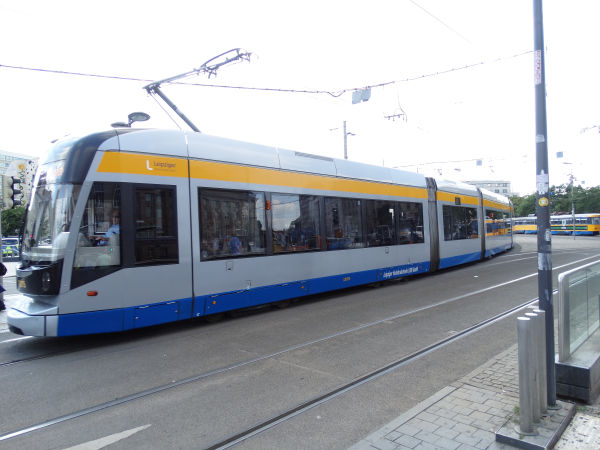
This long and modern tram no.1205 is a 12-axle Bombardier NGT12-LEI delivered in Leipzig in October 2005.
Picture from Leipzig Hauptbahnhof 16.7.2018 by Ilkka Siissalo.
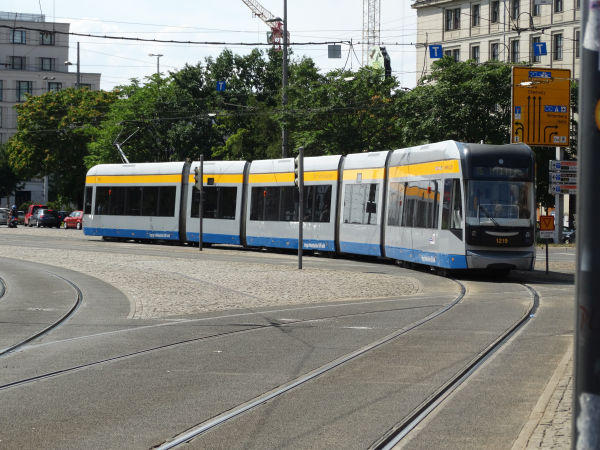
No.1219 is a similar 12-axle Bombardier NGT12-LEI as shown above. This one was delivered in February 2007.
Picture from Leipzig Hauptbahnhof 16.7.2018 by Ilkka Siissalo.
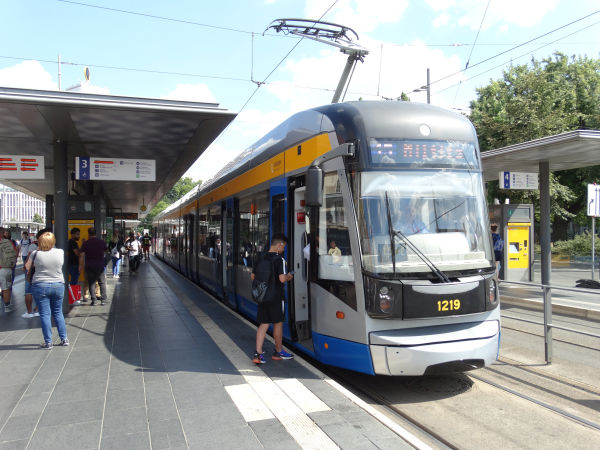
The same tram 1219 as shown above, but here stopping at the Leipzig main station tram stop. The NGT12-LEI is a remarkably
long tram. It's 45 metres long.
Picture from Leipzig Hauptbahnhof 16.7.2018 by Ilkka Siissalo.
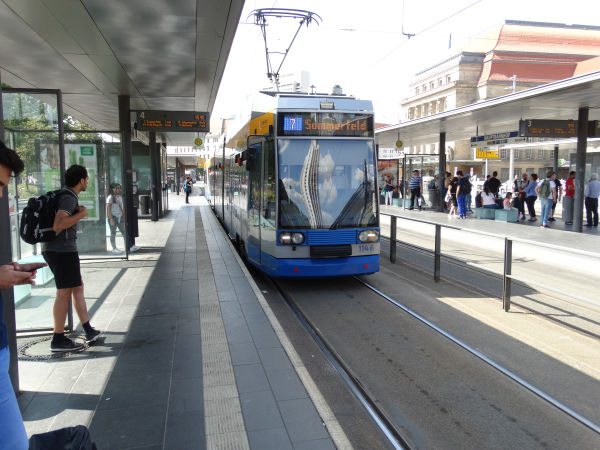
Tram 1146 is of the type NGT8. It was Leipzig's first modern low-floor tram type. They were built bu Düwag, Waggonbau
Bautzen, ABB and Siemens. There are 56 of them and they were delivered 1994 to 1998.
Picture from Leipzig Hauptbahnhof 16.7.2018 by Ilkka Siissalo.
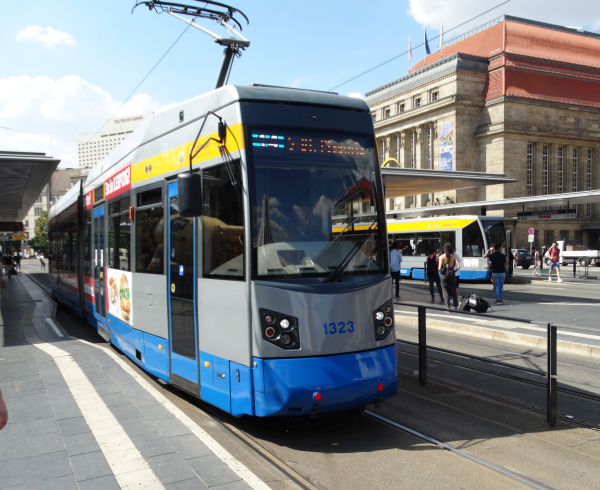
In 2003-04 there were still not enough modern trams in Leipzig and there was not enough money to buy a large series of some of the
most common Western German types, so the Leipzigers started making their own new trams. The model became known as the Leoliner or NGTW6L.
They were built by the company LEOLINER Fahrzeug-Bau Leipzig GmbH. Two prototypes appeared on the streets of Leipzig in 2004 and from
December 2005 to 2009 a total of 50 Leoliners were taken in use. They were not very good trams, there were a lot of troubles with them,
but they are still in 2018 in use on lines 3, 7, 11 and 14, on all other lines as a coupled pair, but on line 14 normally solo. This
is a solo Leoliner on line 14.
Picture from Leipzig Hauptbahnhof 16.7.2018 by Ilkka Siissalo.

A pair of Leoliners on line 7.
Picture from Leipzig Hauptbahnhof 16.7.2018 by Ilkka Siissalo.

This tram no.1007 is one of Leipzig's most modern trams. It was built by the company Solaris in what formerly was the German city
of Breslau, but what today is Wroclaw, part of Poland. It is of the type NGT10-XL and this is still one of the prototypes, the
first of which were delivered in 2016. It's 38 meters long and can take 220 passengers.
Picture from Leipzig Hauptbahnhof 16.7.2018 by Ilkka Siissalo.
Trams of Nordhausen / Nordhausen Stadtwerke
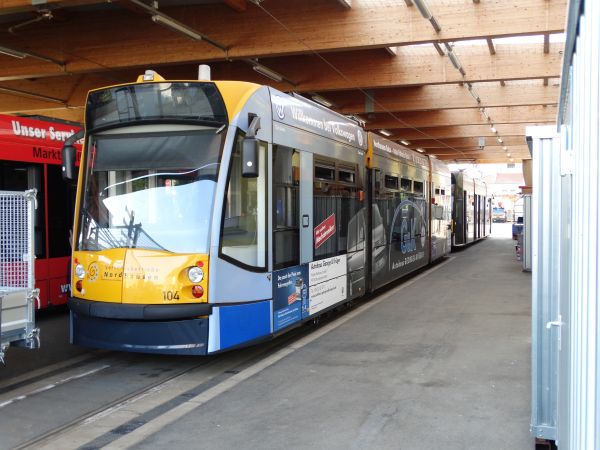
Nordhausen is a small town in former East Germany, in Thüringen (Thuringia). Nordhausen has three tram lines. They are all operated by short Siemens
Combino trams, which Nosdhausen Stadtwerke has in several variants. All variants are only three pieces long. This one, number 104, belongs to a series
of only two trams with just one driver's cab and doors only on one side. These two are made by Siemens in 2002.
Picture from the tram depot in Nordhausen 1.7.2019 by Ilkka Siissalo.
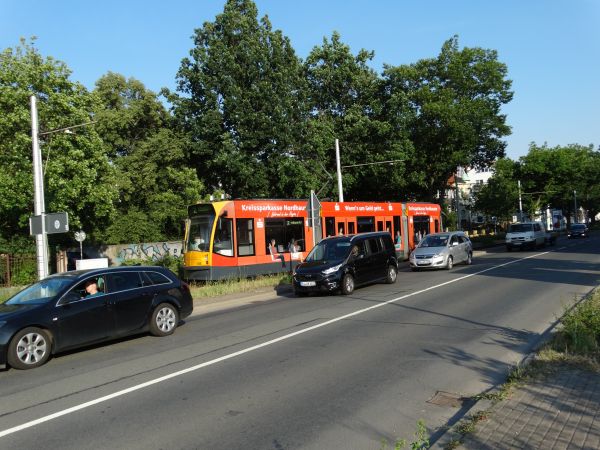
Combino no.105 is one of the variants with two driver's cabs and doors on both sides. It is from 2002.
Picture from the tram depot in Nordhausen 1.7.2019 by Ilkka Siissalo.

Combino no.109 is one of the two newest trams in the city. The trams 108 and 109 are both variants with just one driver's cab and with doors only on
one side. They are from Siemens in Krefeld from 2011.
Picture from the tram depot in Nordhausen 1.7.2019 by Ilkka Siissalo.
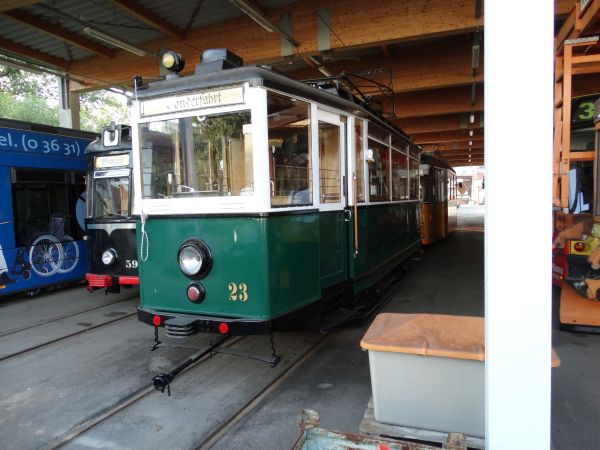
Nordhausen has also a couple of old historic trams left from the communist DDR times and the preceding Nazi times. No.23 is from the year 1934. It was built
in Wismar. No.59 partly visible behind it is one of the famous "Gotha" wagons of DDR and it has formerly been in the city of Erfurt. It is from the year 1961.
It is now set up as a bistro or partywagon.
Picture from the tram depot in Nordhausen 1.7.2019 by Ilkka Siissalo.
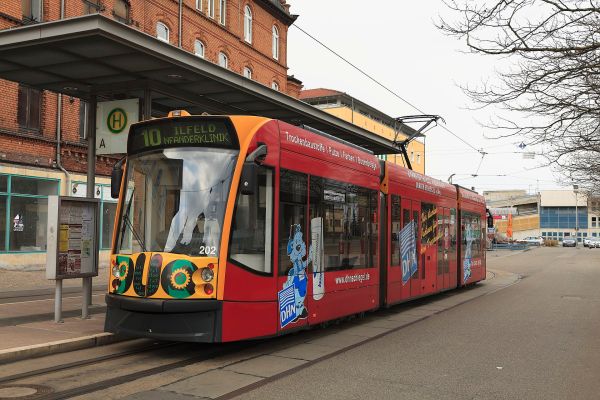
Nordhausen's newest, third tram line no.10 is kind of exotic. It runs from Nordhausen to the town of Ilfeld using mostly the narrow gauge train tracks of
Harzer Schmalspurbahnen HSB's trains. On those lines no catenary wires exist. For this purpose three Siemens Combino Duo trams have been ordered which have in
their middle section a small diesel engine allowing them to operate on the train line.
Picture from Nordhausen Bahnhofsplatz 15.4.2012 by Wikimedia user "Falk2". Published under the Creative Commons
CC BY-SA 4.0 license.
Trams of Potsdam - ViP Verkehrsbetrieb Potsdam GmbH
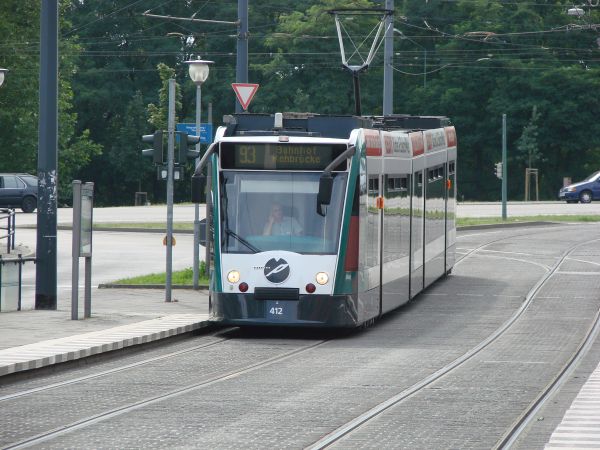
City of Potsdam's tram 412 is a Siemens Combino one-directional articulated tram. Here we see it arriving at the tramstop of Potsdam's
main railway station.
Picture 21.7.2007 by Ilkka Siissalo.
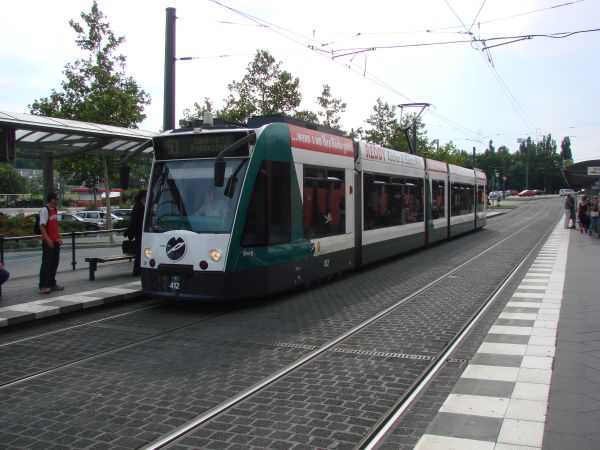
Another view of Potsdam's tram 412 as it was stoppind at Potsdam's
main railway station.
Picture 21.7.2007 by Ilkka Siissalo.

Still the same Combino tram as above, but ow seen from behind.
Picture from Potsdam Hbf 21.7.2007 by Ilkka Siissalo.
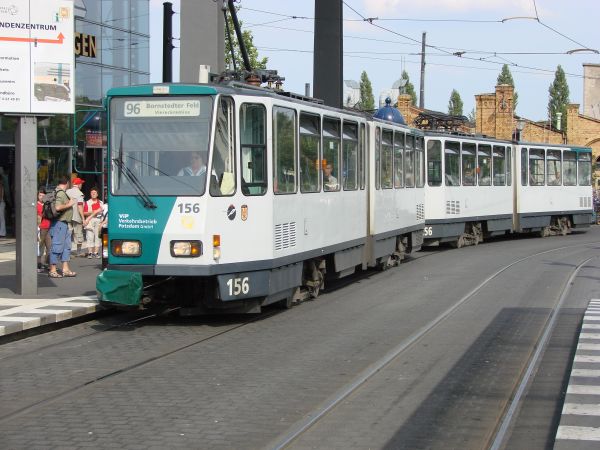
These Tatra KT4D trams are still from East German communist times. They have no low floor space and no airconditioning, so it
is to be expected that they will be retired soon, but some of them were still partly modernised as late as 2011.
Picture from Potsdam Hbf 21.7.2007 by Ilkka Siissalo.

A tram-train of two Tatra KT4D trams at the tramstop of Potsdam's main train station.
Picture from Potsdam Hbf 21.7.2007 by Ilkka Siissalo.
München trams, Münchner Verkehrsgesellschaft MVG, former MVV
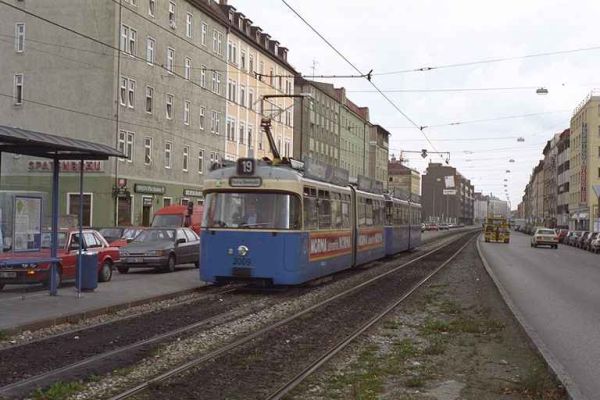
München tram 2009. This is a class P tram built by Rathgeber 1967-69. A two car set can take 315 passengers. Most of the class P trams have been taken
out of service by now.
Photo by Erik Hjelme 23 September 1995.
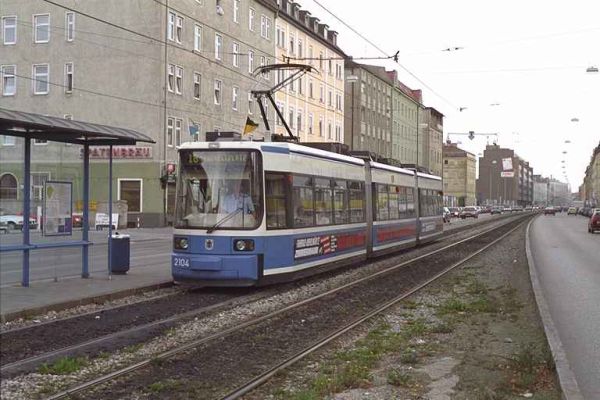
München tram 2104 of a newer lowfloor type. This is an ADtranz tram of the type GT6N, known in München as the type R2. It has space for 157
passengers, of which 58 have a seat.
Photo by Erik Hjelme 23 September 1995.

Another tram of the type R2, also known as ADtranz GT6N. This one is now in the newest livery of Munich's trams.
Picture from the tram stop Theatinerstrasse near München Kunsthalle 24.8.2019 by Ilpo Ruissalo.
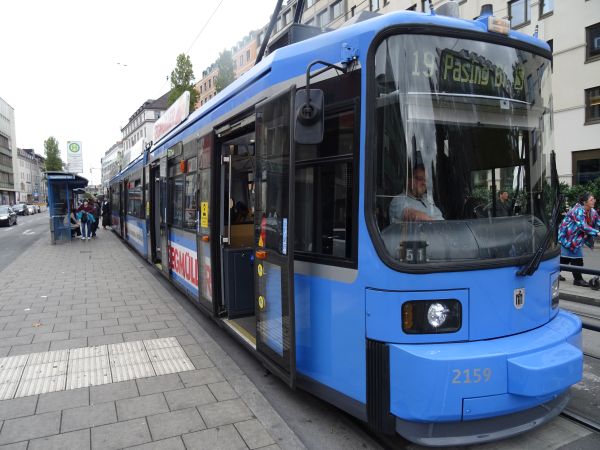
Yet another R2 tram in its newest livery.
Picture from München Hauptbahnhof 14.10.2022 by Ilkka Siissalo.
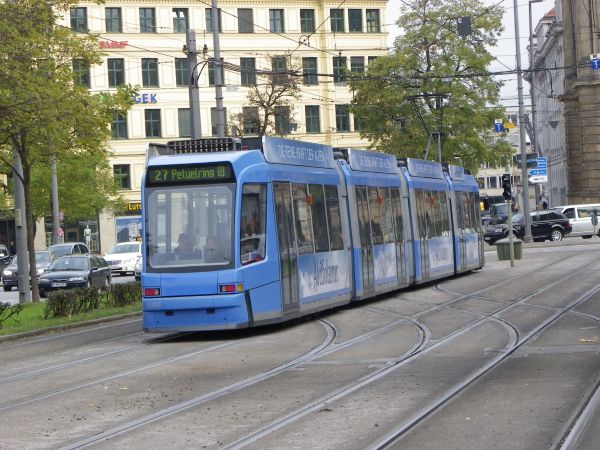
München tram 2207 is an Adtranz GT8N2 from the year 2000.
Photo by Ilkka Siissalo 16.11.2012.
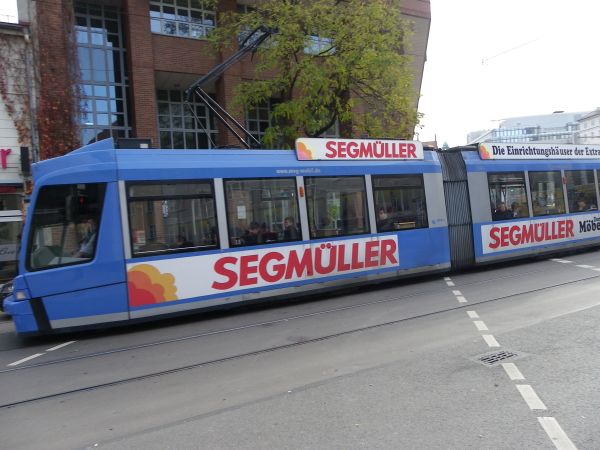
Front part of a similar Adtranz GT8N2 from the year 2000. This is a type specifically designed for München.
It's a four part tram with 8 axles. MVG has 20 of them.
Photo by Ilkka Siissalo 16.11.2012.
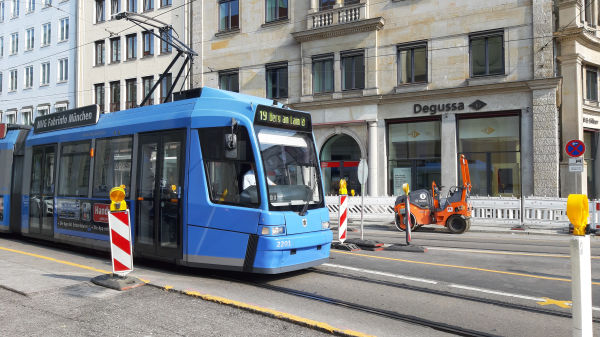
Front part of another ADtranz GT8N2.
Picture from the tram stop Theatinerstrasse near München Kunsthalle 24.8.2019 by Ilpo Ruissalo.
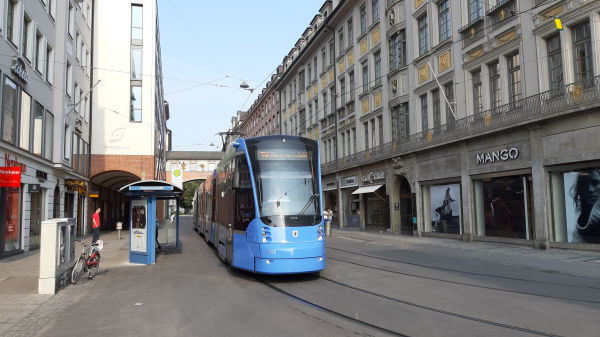
This is a Siemens Avenio, also known in München as tram type T. They
came in use in 2017.
Picture from the tram stop Theatinerstrasse near München Kunsthalle 24.8.2019 by Ilpo Ruissalo.
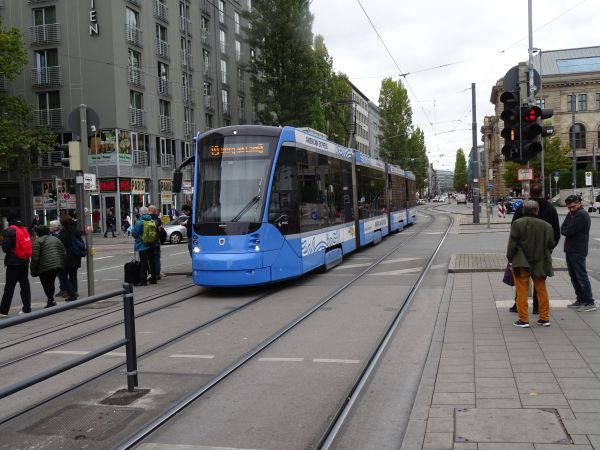
Another Siemens Avenio, here just approaching the tramstop in front of München Hauptbahnhof.
Picture from München Hauptbahnhof 14.10.2022 by Ilkka Siissalo.
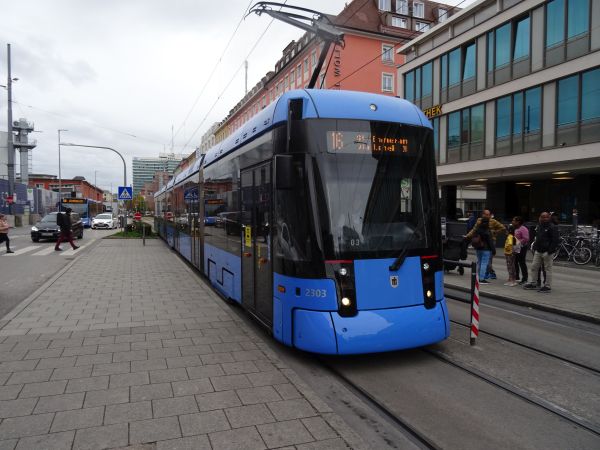
This one is a Stadler Variobahn which in München is called Baureihe S. MVB ordered fourteen of these trams 2008-09 and eleven are still in use.
There have been plenty of technical problems with these trams, just like in other cities using these Variobahn models.
Picture from München Hauptbahnhof 14.10.2022 by Ilkka Siissalo.
Trams of Rostock, Rostocker Straßenbahn AG, RSAG
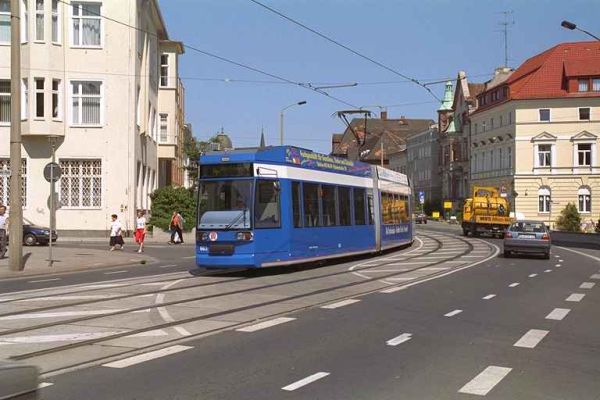
Rostock tram 633 of the DÜWAG / Siemens type 6NGTWDE.
Photo by Erik Hjelme 27 July 1995.

A similar Siemens / Düwag 6N GTW.
Photo by Ilkka Siissalo 23.7.2004.
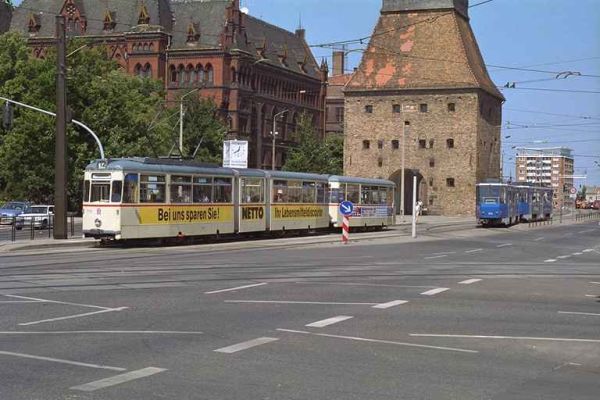
Rostock tram 715. This old ex-DDR type is nicknamed "two rooms and a kitchen",
Here the tram is coupled to an additional trailer.
Photo by Erik Hjelme 27 july 1995.
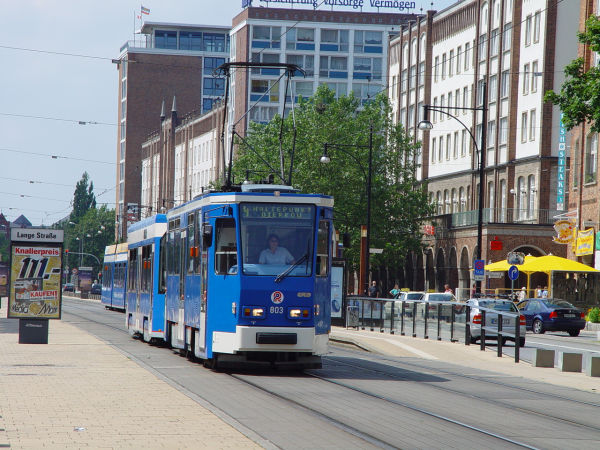
A tram-train consisting of one old but modernised Tatra-wagon plus a new low-floor trailer.
Picture 23.7.2004 by Ilkka Siissalo.
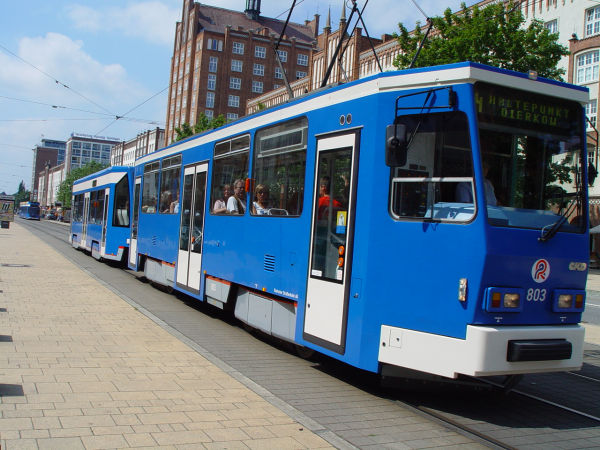
The same tram-train as above. The old Tatra T6A2m has received in its modernisation new doors. The last ones of these Tatra
trams were taken out of use in 2015.
Picture 23.7.2004 by Ilkka Siissalo.
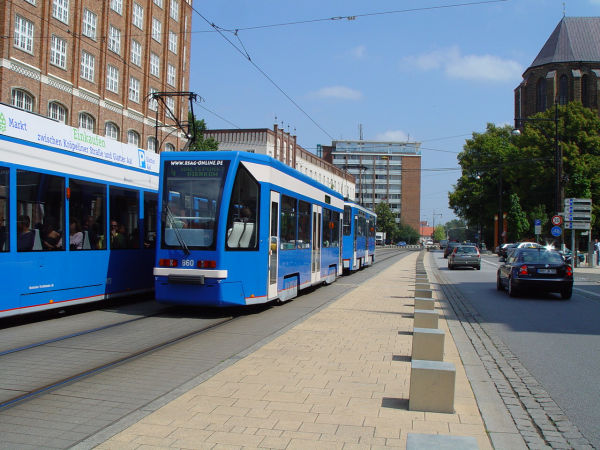
These new 4NBWE trailer wagons were bought in order to modernise Rostock's old Tatra trams, but when Rostock got rid of all
Tatras, also these trailers were sold. Some went to Leipzig and some to Szeged.
Picture 23.7.2004 by Ilkka Siissalo.
Saarbahn
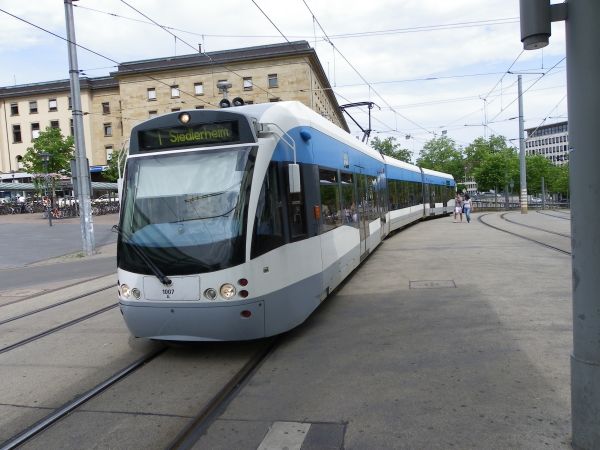
Sarbahn is a tram / light rail system which operates around the city of Saarbrücken in western Germany. It's a so called tram-train
which runs on its own tracks in the city but also runs on regular train tracks both inside Germany and also into neighbouring France.
The operator of Saarbahn is the company Stadtbahn Saar GmbH. Saarbahn's trains run with 750V DC inside the city but can also run under
15 kV AC when running on railway lines. The main line extends to Sarreguemines in France. These trains are Flexity Link tram-trains built
by Bombardier.
Picture from Saarbrücken 12.7.2010 by Ilkka Siissalo.
Trams of Ulm
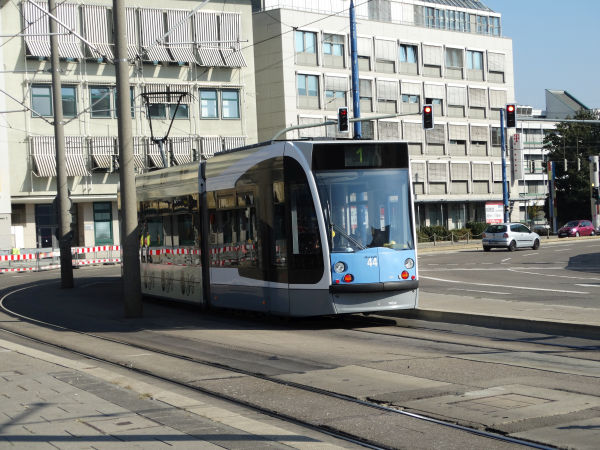
The city of Ulm has currently only two tram lines and actually they also are just end to end, one long line. There was earlier
a plan for five lines, but a local voting turned it down. All the trams are Siemens Combinos or the newer Siemens Avenios.
Avenio is the successor model built based on the Combino.
This tram no. 44 is one of the Combinos, here on line 1, just leaving the main station.
Picture from Ulm Hauptbahnhof (main station) 14.9.2016 by Ilkka Siissalo.
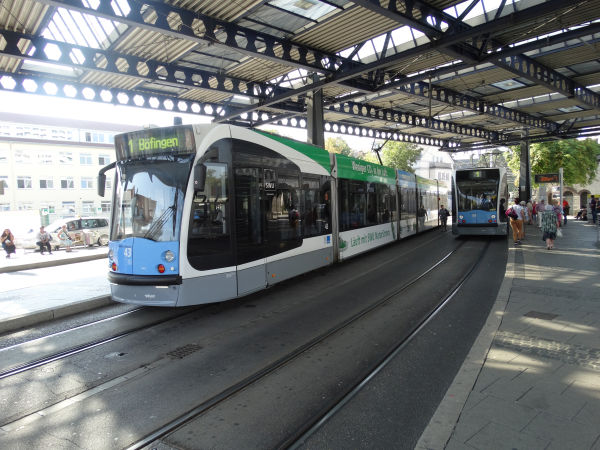
Two Combinos, numbers 43 and 49 stopping on line 1 at the main station.
Picture from Ulm Hauptbahnhof (main station) 14.9.2016 by Ilkka Siissalo.

Ulm's Combino tram no.41 "Albrecht Berblinger" is approaching th tramstop of Ulm main train station. All of Ulm's trams carry individual names, typically of
famous citizens of the city.
Picture from Ulm Hauptbahnhof (main station) 3.7.2019 by Ilkka Siissalo.

The very newest trams of Ulm are also made by Siemens just like the earlier Combino trams, but these are no longer Combinos. Siemens calls this
newer type Avenio M. City of Ulm bought twelve of these new Avenios.
Picture from Ulm Hauptbahnhof (main station) 3.7.2019 by Ilkka Siissalo.

Avenio no. 54 "Felix Fabri" is boarding passengers at Ulm's main railway station.
Picture from Ulm Hauptbahnhof (main station) 3.7.2019 by Ilkka Siissalo.

Side view of the same Avenio no. 54 "Felix Fabri" as shown above.
Picture from Ulm Hauptbahnhof (main station) 3.7.2019 by Ilkka Siissalo.
Trams of Würzburg - Würzburger Straßenbahn GmbH

This is the so far newest tram type of the city of Würzburg, called GT-N. This model was Würzburg's first totally low-floor tram type and
it was built by a consortium of Siemens and Linke-Hoffman-Busch. There have been repeated and serious technical problems with this type
and since 11/2023 and maybe even until 2025 they have all been pulled out of service. This picture is from July 2023 when still a part of them
were being used in regular traffic.
Picture from Würzburg Hauptbahnhof (main station) 10.7.2023 by Ilkka Siissalo.
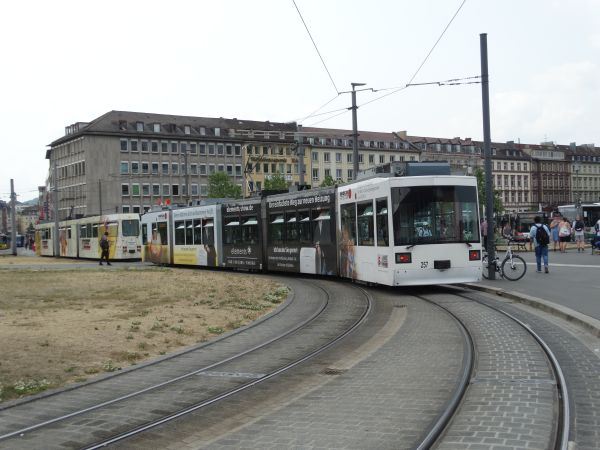
The same GT-N tram as above but now seen from behind. All of Würzburg's GT-N trams except one should be 100% covered by advertisement
tapings, but this one had apparently suffered some collision damage which has been repaired so that only its left side was covered with these
ugly tapings.
Picture from Würzburg Hauptbahnhof (main station) 10.7.2023 by Ilkka Siissalo.
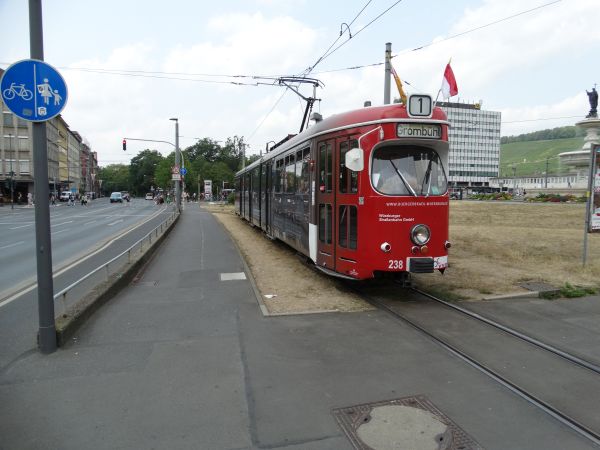
One of Würzburg's old GTW-D8 trams. These old trams were built by Düwag 1967-68. This one is from a series built in 1968. When they were new, they
had only six axles, but they in 1982 got an added middle section changing the type from GTW-D6 to GTW-D8. The added middle section added also so
much extra eight to the trams that a second motor was deemed necessary as well. But even with two motors they still cannot be used on the tram line
up a steep hill to Heuchelhof, they are too weak for that steep slope.
Picture from Würzburg Hauptbahnhof (main station) 10.7.2023 by Ilkka Siissalo.

The same old Düwag tram seen from behind. They were built so that they have a full set of doors only on the right hand side, but they can still
temporarily be used driving in the other direction. The driver has a possibility to control the wagon also from its back, but he/she doesn't have
a proper seat there. At the very back of the tram there is one pair of doors on both sides.
Picture from Würzburg Hauptbahnhof (main station) 10.7.2023 by Ilkka Siissalo.

This picture shows how the tram has one pair of doors that can be used if it is temporarily being used "the wrong way". Today these doors "on the
wrong side" are not used any more and they are permanently blocked.
Picture from Würzburg Hauptbahnhof (main station) 10.7.2023 by Ilkka Siissalo.
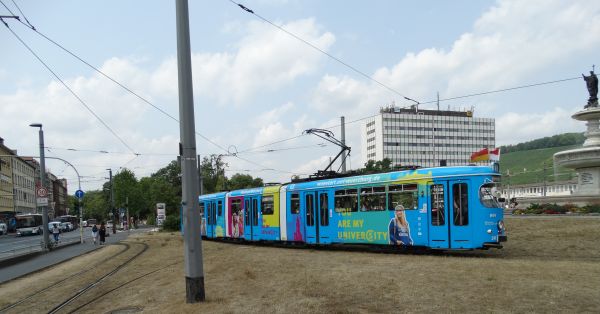
In 1975 Würzburg got eight more Düwag trams which were already at the factory built as eight axles long models. They differ slightly from the older
series, for example they have different doors.
Picture from Würzburg Hauptbahnhof (main station) 10.7.2023 by Ilkka Siissalo.
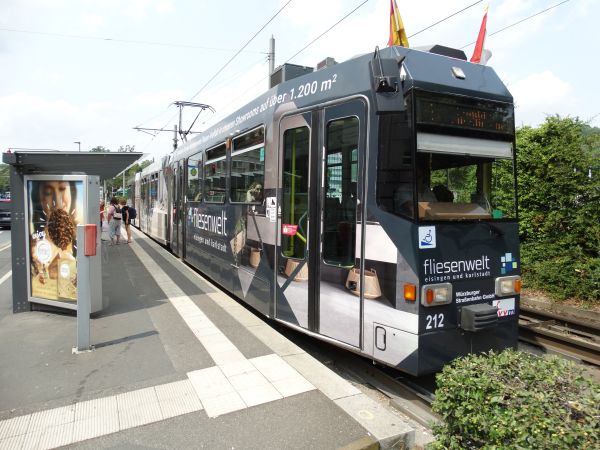
Würzburg's tram type GT-E. These trams were delivered 1988-89 by Siemens and Linke-Hoffman-Busch. These were needed as the city of Würzburg opened
a new tram line which climbs very steeply uphill to Heuchelhof. These trams have a low-floor middle section and exceptionally strong motors.
Picture from Würzburg Hauptbahnhof (main station) 10.7.2023 by Ilkka Siissalo.
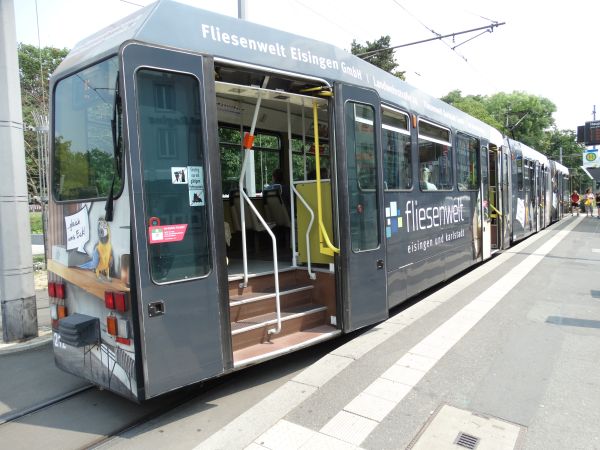
The same GT-E tram seen from behind.
Picture from Würzburg Hauptbahnhof (main station) 10.7.2023 by Ilkka Siissalo.
Trams of Zwickau - Städtische Verkehrsbetriebe Zwickau SVZ

Zwickauer tram no.904 is of the type MAN GT6M from 1993.
Photo by Alfred Slotosch in 1995.

